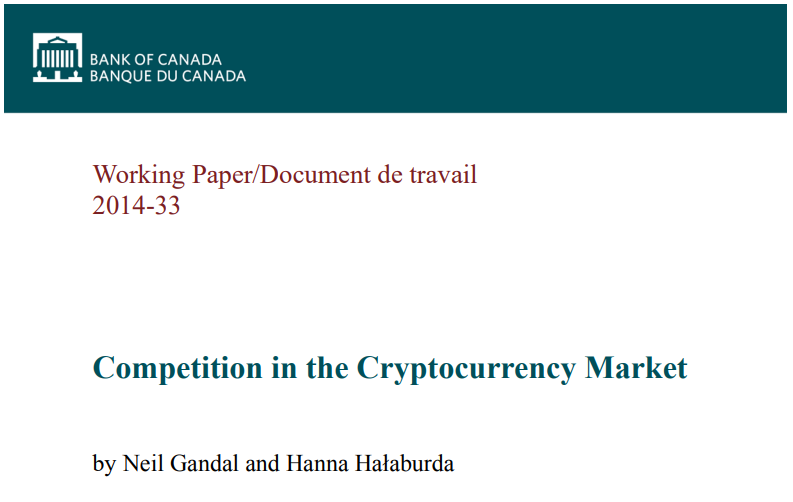
1 Introduction
Even though it was introduced in 2009, the digital currency Bitcoin caught the interest of
the mainstream media only in 2012. Due to its supposed anonymity, Bitcoin and other
digital currencies are often compared to cash. However, unlike cash, these currencies are
purely digital and used primarily online. Digital currencies have the potential to compete
against other online payment methods such as credit/debit cards and PayPal. It is possible
that Bitcoin and other digital currencies may have a large long-term effect on both currency
and payments systems, but these currencies are currently in their infancy. There are many
unanswered questions about their viability, as well as the potential of digital currencies to
be a disruptive technology.
Current developments within the Bitcoin ecosystem, as well as competition with other
digital currencies, may have an important impact on the future success of this technology.
We focus on decentralized digital currencies that use cryptography, called cryptocurrencies.
In this paper, we analyze how network effects affect competition in the nascent cryptocur-
rency market. We do so by examining the changes over time in exchange rate (price) data
among cryptocurrencies. Specifically, we look at two aspects: (1) competition among differ-
ent currencies (Bitcoin, Litecoin, etc.), and (2) competition among exchanges where those
currencies are traded. Because the supply of cryptocurrencies is either fixed or determinis-
tically changing, changes in prices are a good indication of changes in demand.
Both in the context of currency competition and competition between exchanges, network
effects play an important role. Positive network effects are present when the value of a
product or service increases with the number of users. A currency is more useful as more
people adopt it. An exchange is more liquid when there are more buyers and sellers. From
the ‘network effects’ literature (cf. Katz and Shapiro 1985), in such environments we might
expect a “winner-take-all” dynamics and convergence to one dominant player. The more
popular the currency the more easily it can attract new users. Similarly, the larger exchange
will be more attractive to new buyers and sellers. Therefore, the larger competitor will grow
even larger, eventually dominating the whole market. In this paper, we ask whether the
“winner-take-all” dynamics is an important force for the competition between currencies,
and for the competition between the exchanges. We do not see a clear winner-take-all
dynamics currently in the cryptocurrency market.
The lack of winner-take-all dynamics is less surprising for the exchanges. The nature
2
of network effects is different for currency competition than for competition between the
exchanges. In the exchanges, sellers benefit from a larger number of buyers, and buyers
benefit from a larger number of sellers (so-called positive cross-side effects). However, sellers
would prefer a lower number of other sellers, since they compete for buyers. Similarly, buyers
would prefer a lower number of other buyers competing against them (so-called negative
same-side effects). There are no such negative effects for currency adoption—it is always
positive when more users adopt it. In the case of exchanges, the negative same-side effects
may counter the “winner-take-all” dynamics (cf. Ellison and Fudenberg 2003; Halaburda
and Piskorski 2011). Therefore, in an equilibrium multiple exchanges may coexist, as long
as they do not provide arbitrage opportunities (i.e., neither buyers nor sellers would gain by
trading at a different exchange).
The market for exchanges is very vibrant. The exchanges considered to be the “major
players” changed significantly over time. New ones appeared, and existing ones were pushed
out of the market. The Mt. Gox failure in February 2014 showed that even a large exchange
may suddenly exit the market.
Although we have price data at only one moment a day (24:00 GMT), we examine whether
there are profitable trading opportunities both within the BTC-e exchange and across the
BTC-e exchange and some of the other major exchanges. We find that profitable (gross)
trading opportunities are much larger across exchanges than within the BTC-e exchange.
With this analysis we provide a first glimpse into trading opportunities in cryptocurrency
markets. It is not a comprehensive test for arbitrage opportunities, since arbitrage opportu-
nities can exist at any point in time, and we examine only a few of the exchanges. We will
examine this issue in more detail in future research.
In competition between cryptocurrencies, we see that some of the analyzed currencies lose
value and do not recover, while others keep their value for a long time. Thus, consistent with
the winner-take-all dynamics, there are “winners” and “losers,” and a successful currency
grows more successful. But the winner-take-all dynamics is not the only force in this market,
and we do not see the market tipping to one dominant currency.
Our data suggest that the winner-take-all effect is dominant only early in the market.
During this period, when Bitcoin becomes more valuable against the USD, it also becomes
more valuable against other cryptocurrencies. Bitcoin is the most popular cryptocurrency
at the beginning of this period and during the period it further improves its position, both
against the USD and against other cryptocurrencies.
Competition in the Cryptocurrency Market by Neil Gandal and Hanna Hałaburda




